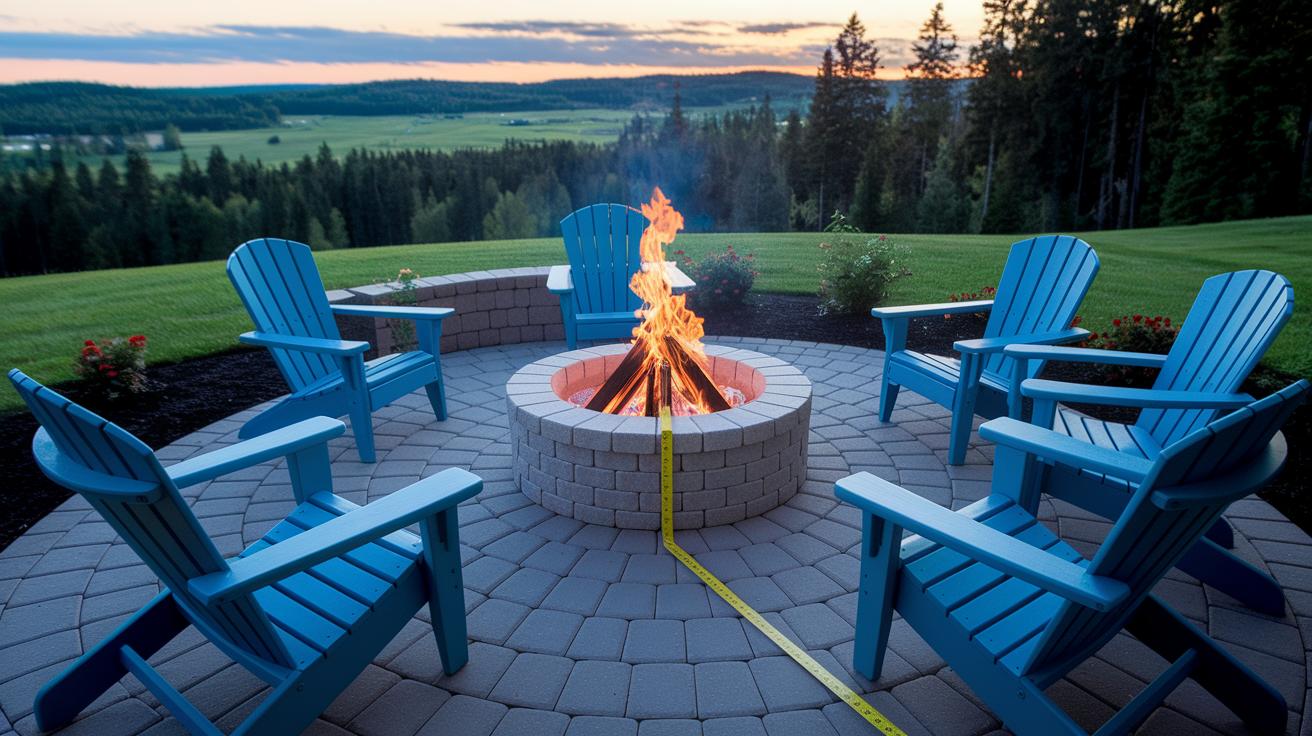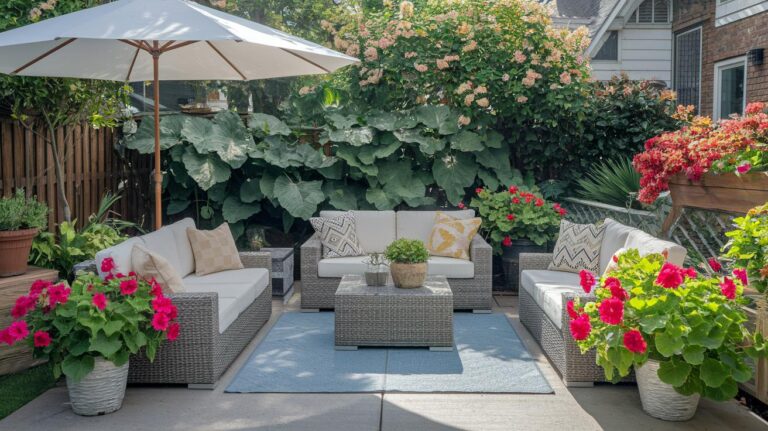Patio Fire Pit Placement And Safety Distances Guaranteed
Hey neighbor, have you ever settled in for a cozy backyard fire and felt the warm glow on your cheeks? It’s that soft crackle and dancing light we all love.
But picture this: a glowing ember (a small piece of hot wood) lands on your wood deck and sends you scrambling for the hose. Oops, I nearly raced inside for buckets of water. It’s enough to ruin any s’mores party.
Here’s the trick. Give your fire pit at least 10 feet of empty space all around, like a dance floor where sparks can’t step on toes. Then clear a three-foot spark-free zone free of chairs, cushions, or anything that could catch fire.
Follow these simple steps and you’ll set up a patio fire pit that lights up crisp evenings without torching your deck or your wallet.
Core Clearance Standards for Patio Fire Pit Placement
Thinking about adding a patio fire pit? Imagine flickering flames and the warm glow dancing on your face. To keep that magic safe, you’ll need plenty of empty space around your fire pit.
- Keep at least 10 feet of open space around the pit. That’s about the length of a large SUV parked nose-to-tail.
- Make sure you have a 3-foot clear zone (area free of anything flammable) all the way around. No dry leaves, mulch (decayed wood chips), wood decking, or other tinder-like stuff.
- Don’t put your fire pit under low-hanging branches, eaves (roof edges), pergola rafters, or fabric awnings. You don’t want stray sparks landing on things that burn.
By the way, your town office usually posts permit requirements online or at city hall. Before you dig or pour a stone base, double-check spacing rules and setback requirements from your house walls. A quick call or click can keep you out of trouble and keep your neighbors happy.
I like to grab a tape measure and chalk or string, then sketch my pit’s clearance zone (the area that must stay clear). Draw circles or squares where the pit will sit. It’s like planning a little dance floor for your flames. This simple diagram helps you spot any sneaky plants, benches, or grill tools before you light up.
Now that your dimensions are marked, you’re ready to pick a pit model and build a sturdy noncombustible platform (fireproof base) in the sweet spot of your yard. Then light it up and enjoy the crackle and glow on cool evenings.
Choosing a Noncombustible Patio Base for Safe Fire Pit Placement

Putting your fire pit on a heat resistant base keeps the warmth in one spot and your deck safe. Stone, concrete, or gravel soak up the heat and stop little embers from hopping around. Have you ever felt a hot spark land on your deck? Yikes.
So pick a material that stays cool, won’t warp, and can’t burn. Then circle the pit with gravel or pavers to catch stray sparks and ash bits. A neat row of bricks or a stone edge gives extra protection and looks sharp, too!
Here are some top noncombustible options to set under your fire pit:
- Stone pavers (like bluestone or limestone)
- Concrete slabs or blocks
- Gravel bed (loose crushed stone, about ¼ to ½ inch thick)
- Brick paver ring
- Metal fire rated base plate (heat resistant plate)
For extra peace of mind, lay a 2 to 4 inch gravel ring right around your fire pit. That way you can scoop up ashes in a snap. By the way, sweeping up is a breeze. And brick or stone edging keeps hot bits from rolling onto the rest of your patio.
I wouldn’t set a fire pit on wood decking or composite boards without a heat shield panel underneath. Sure, it’s an extra step, but it can save you a big headache and costly repairs later.
Patio Fire Pit Placement And Safety Distances Guaranteed
When you tuck a fire pit under a roof or peek through pergola beams (garden structure with open slats), check the space above first. Sparks can drift up with that warm glow, so you’ll want plenty of room to breathe. Have you ever watched sparks swirl in a breeze? Pick a spot where gusts gently push embers away from any cover.
By the way, I love the smell of wood smoke on a cool evening.
Awning and Canopy Clearance
Keep at least 10 feet of clear space straight up from any fabric or metal awning. That’s about the height of a single-story garage. Fabric panels should be flame-retardant (treated to resist catching fire) and metal covers need spark-safe coatings (surfaces that stop hot bits). Before you light up, measure from the ground to the lowest part of the canopy. If you’re unsure, add a couple more feet. Extra sky never hurts.
Pergola and Roof Overhang Safety
Under wood rafters (slanted support beams), aim for at least 6 feet of headroom. Then slip in steel or aluminum panels above your pit to shield wooden joists (horizontal support boards). These metal sheets won’t burn and will catch stray sparks before they land on wood. Make sure the pit sits in the center so embers drift away from posts or nearby walls. And here’s a trick: light a small scrap of paper to see which way the breeze carries sparks so you can orient your pit safely.
Landscaping and Surrounding Buffer Zones for Fire Pit Safety

Hey neighbor! I love cozy nights by the fire pit, but mulch or wood chips can smolder and send sparks flying. Oops, I nearly lost my sedum once to a stray ember!
So here’s a simple fix: surround your fire pit with a circle of gravel (small, rough stones that crunch underfoot) or crushed stone (broken rock pieces). Then press in a metal or stone edging (a sturdy border) around that ring to block stray embers. Now your grass, groundcover, and garden blooms stay safe and spark-free.
Fire Pit Safety Equipment and Emergency Preparedness
Ever watched a stray ember dance on your patio stones? The crackle and smoky scent bring instant coziness. But also a little worry. Having the right gear close by means you can stop trouble before it sparks a bigger mess.
- Attach a mesh spark arrestor (a metal screen with 1/2-inch holes that stops flying sparks) on top of your pit. It grabs hot bits before they drift into your flower beds or near your seating.
- Keep a charged fire extinguisher (you know, that red canister you pull a pin on) and a garden hose within 10 feet. Flames popping up where they shouldn’t? Water or foam will be ready in seconds.
- Tuck a fire-rated blanket (a heavy fabric that smothers flames) right beside the pit. When wind fans the embers or logs roll, just toss the blanket over, problem gone.
- If your patio has walls or a roof, place a carbon monoxide detector (an alarm that warns of deadly gas) about 10 feet away. That soft beep might be the heads-up you need on a still, chilly night.
By the way, my cat always thinks it’s a sunbeam spot. But back to safety…
Emergency Shut-Off Steps
- Turn off the fuel supply, close the propane valve or shut the gas line.
- Lay the fire-rated blanket or your fitted cover over the glowing embers.
- If you still see flickers, spray a light mist from the hose or extinguisher.
- Call 911 if the fire spreads beyond your pit.
Having these tools and a clear plan feels as good as that first cozy spark.
Fuel Types, Storage Clearances, and Use Guidelines for Patio Fire Pits

Let’s pick fuel that keeps you cozy and safe. Natural gas or propane gives a steady flame and barely any fuss. Seasoned hardwood (wood dried for at least six months to burn evenly) adds that warm, smoky scent without big sparks. And uh, skip accelerants like lighter fluid (fire-starting stuff) because they can cause wild flare-ups.
Store your firewood at least 30 feet from the pit in a dry spot. A simple lean-to or covered rack keeps logs ready and mold-free. Need tips on stacking and seasonal care? Check out gas vs wood burning patio fire pit pros and cons for advice on moving wood after storms and keeping it neat.
Propane tanks? Treat them like VIP guests, keep them at least 10 feet away. Run your gas lines through approved PVC conduit (sturdy plastic pipe) or steel conduit (metal pipe that shields hoses). And give hoses and pipes a little wiggle room, at least 3 feet from hot parts, so they don’t melt. Think of it as your safety bubble. No shortcuts here.
When the fire dies down and embers cool, slip on a fitted cover. It keeps rain, leaves, and dust out so you’ll light up faster next time. A snug cover also stops critters from moving in. Pro tip: store the cover a few inches above the pit so moisture can drip away.
Little habits, like checking hose fittings and wiping off ash, mean more evenings under that cozy glow and fewer surprise sparks.
Seasonal Maintenance and Risk Mitigation for Patio Fire Pit Safety
Have you noticed leaves piling up around your fire pit? After strong winds, or at least every couple weeks, sweep up any leaves within ten feet. Those damp bits can hide under the spark screen (mesh cover that catches big sparks) and smolder, sending hot embers into your grass or wood mulch.
When frost dusts your patio in the morning, grab a plastic shovel or soft-bristle broom to clear snow and ice from the pit surface and nearby pavers. By the way, my dog always skitters across those slick stones – fun to watch but not so safe.
Before you light the fire, check a wind gauge (tool that measures breeze) or your local forecast. If gusts top fifteen miles per hour, save the fire for a calmer evening. Floating embers can drift into flower beds or hop over fences.
After heavy rain, water can pool in the pit bowl, soak your wood, or start rust. Keep a snug cover on hand and tilt it so rain runs right off. Also, glance at your patio slope to make sure water flows away and not underfoot.
When each new season rolls around, lift the spark arrestor (that wire mesh lid) and look for holes, rust, or ash build-up. Squeeze your gas hoses and fittings to spot leaks or cracks. Tighten loose clamps and swap out any frayed hoses so every spark stays right where it belongs.
Final Words
You're all set to measure that 10 ft clearance, set up a solid base of stone or pavers, and fit a spark arrestor for contained embers.
We covered overhead gaps under pergolas and awnings, buffer zones around plants, and key safety tools like fire extinguishers and carbon monitors.
You also saw safe fuel storage tips and seasonal checks to keep everything running smoothly. So grab your measuring tape, pick the right spot, and look forward to cozy evenings powered by correct patio fire pit placement and safety distances.







